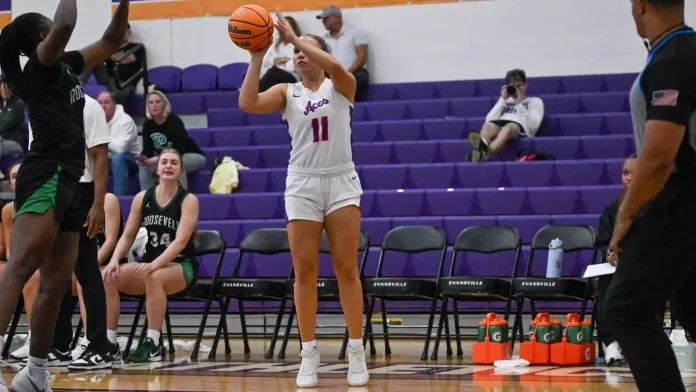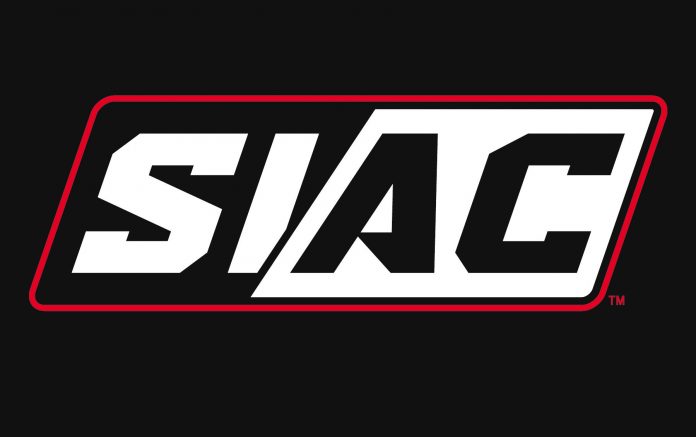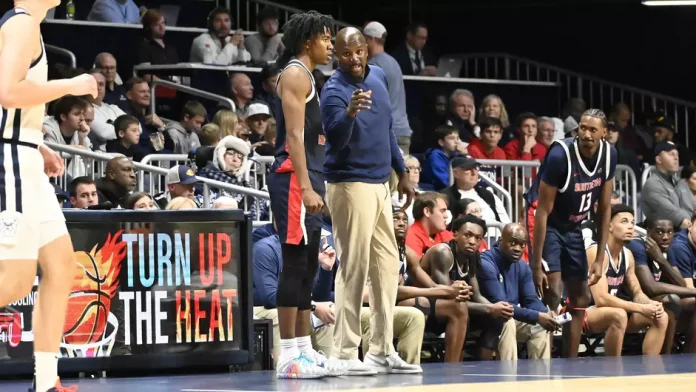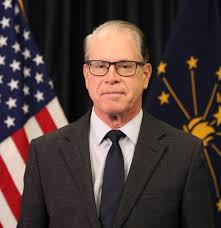|
||||||||||||||||||||||||||||||||||||||||||||||||||||||||||||||||||||||||||||||||||||||||||||||||||||||||||||||||||||||||||||||||||||||
|
HOT JOBS
Aces Place 6 on MVC Scholar-Athlete Team
Following a successful 2025 campaign on and off the pitch, six UE women’s soccer student-athletes have been named to the MVC Scholar-Athlete Team, the league office announced on Tuesday.
Lindley Amick (Las Vegas, Nev./Faith Lutheran) earns a spot on the MVC Scholar-Athlete Team after playing all 1,440 minutes this season as an anchor of the Purple Aces’ defense. The sophomore owns a 4.00 GPA as a Sports Communication major at UE.
Fellow sophomore Emmy Brenner (Arlington, Tenn./St. Benedict at Auburndale) receives Scholar-Athlete recognition following a season that saw her make 14 starts and play 1,182 minutes as a midfielder and defender while adding a goal. Brenner owns a 3.739 GPA as a Biology major.
Another mainstay in the UE lineup, Ella Hamner (Evansville, Ind./Memorial) lands on the Scholar-Athlete Team after starting all 16 matches while scoring a goal and adding an assist for three points. The junior owns a 3.389 GPA while majoring in Health Services Administration.
Second Team All-MVC selection Taylor Johnson (Evansville, Ind./Reitz) receives Scholar-Athlete honors for the second time in her career after landing on the Scholar-Athlete Second Team last season. As a junior this season, Johnson scored three goals while tallying three assists, finishing second on the team with nine points. Johnson boasts a 4.00 GPA while majoring in Chemistry.
Third Team All-MVC pick Allie Lammers (Cincinnati, Ohio/Mount Notre Dame) earns Scholar-Athlete recognition following a breakout sophomore campaign as the Aces’ primary goalkeeper. Playing in 13 matches with 11 starts, Lammers posted a 6-4-1 record and recorded five shutouts with a 1.00 goals against average and .793 save percentage. Lammers owns a 3.762 GPA as a Marketing major.
Senior Kathryn Tyler (Dallas, Texas/Liberty Christian) after a career year that saw her post career-highs across the board. Playing in 15 matches with 11 starts, Tyler played 913 minutes on the season while adding a goal in her final season of collegiate soccer. Tyler carries a 3.935 GPA with a major in Psychology.
Purple Aces Continue Road Swing at EKU
EVANSVILLE, Ind. – The University of Evansville women’s basketball team continues its season opening road trip on Wednesday, traveling to Richmond, Ky. to battle Eastern Kentucky. Tip-off is scheduled for 6 PM CT from Baptist Health Arena.
Series History
– Wednesday marks the seventh meeting all-time between Evansville and EKU
– The Purple Aces and Colonels are playing each other for the fourth time in the last five years, with the Purple Aces taking three of the last four meetings, including two of three under Head Coach Robyn Scherr
– The last meeting in Richmond came in 2022-23, with the Purple Aces taking an 89-81 win
– Myia Clark tied the program single-game record for three pointers in the win, sinking 8. Current Assistant Coach Anna Newman added 15 points for UE
Among the Best
– After finishing last season sixth in the country in free throws made and free throws attempted per game last year, Camryn Runner again ranks among national leaders at getting to the free throw line
– Through two games, Runner ranks 29th in the country in free throw attempts per game (8.5) and 31st in free throws made per game (6.0)
– In last Thursday’s opener at SEMO, Runner went 12-for-17 from the line en route to a 26-point performance
Playing Fast
– In what has been a staple under Head Coach Robyn Scherr, the Purple Aces have played at one of the fastest paces in the country this season
– Evansville ranks fifth in the country in pace (possessions for each team per 40 minutes) through two games
– In five seasons under Scherr, Evansville has ranked in the 91st percentile or higher nationally in pace each year
Aces face MTSU on Wednesday at the Ford Cente
Game time set for 7 p.m.
EVANSVILLE, Ind. – In the third of a 4-game homestand, the University of Evansville men’s basketball team welcomes Middle Tennessee State to the Ford Center on Wednesday for a 7 p.m. game. ESPN+ and the Purple Aces Radio Network will have the broadcast of both contests.
Last Time Out
– After leading by as many as 30 points, the Purple Aces defeated Oakland City by a final of 76-47 on Sunday
– Josh Hughes and Bryce Quinet led UE with 13 points apiece while Connor Turnbull added 12 and AJ Casey scored 10
– Leif Moeller registered 8 assists, 8 boards, and 7 points in the victory
Double-Double
– For the second time in his UE career, Josh Hughes registered a double-double in the opener at #1 Purdue finishing with 15 points and a career-high 11 boards
– Hughes enters Wednesday’s game as the top scorer on the team with 13.3 PPG and is tied for the team lead with 6.33 boards
– He is second in the MVC with 3.33 offensive caroms per contest
Mid-season Form
– After missing the opener at Purdue, Connor Turnbull made his season debut against Calumet
– In two games, Turnbull is averaging 9.0 points and 5.0 rebounds
– He paces the MVC with 2.5 blocks per contest
– Turnbull finished with 12 points and four blocks in the win over Oakland City
Hit the Ground Running
-Freshman Bryce Quinet has enjoyed a solid start to his collegiate career
– His point tally has risen each time out from four points at Purdue, 7 versus Calumet, and 13 against Oakland City
– Quinet posted four assists and four boards against Calumet before registering three steals versus the Mighty Oaks
Top Three
– Through three games, Leif Moeller ranks third in the MVC with his average of 6.33 assists per game
– Moeller has recorded eight assists in each of the last two games and stands at 19 on the season
– He put together a stellar all-around effort versus Oakland City totaling 8 assists, 8 boards, and 7 points
Scouting the Opponent
– Middle Tennessee State enters Wednesday’s game with a 2-0 mark following victories over Milligan and Webster
– On Saturday, the Blue Raiders defeated Webster by a final score of 109-56
– Five MTSU players scored in double figures with Chris Loofe and Jahvin Carter scoring 14 apiece
– Kamari Lands leads the Blue Raiders with 15.0 points per game while Carter is second on the team averaging 13.0 PPG
– Loofe is the leading rebounded on the squad with 9.0 per game
EPD DAILY ACTIVITY REPORT
FOOTNOTE: EPD DAILY ACTIVITY REPORT information was provided by the EPD and posted by the City-County-County Observer without opinion, bias, or editing.
One Arrested After Overnight Murder Investigation
On 11/10/2025 officers were dispatched to the 5500 block of Carriage Dr in reference to a shots fired run. Multiple 911 calls were received as officers responded to the scene. One caller reported that a male had been shot and was unresponsive. Officers arrived and located the victim, who was transported to a local hospital but did not survive his injuries.
Detectives learned that Drasean A. Hogan (21) was at the residence and got into an argument with his girlfriend. During the argument another female tried to intervene, leading to a physical fight between Hogan and the second female. During the altercation, Hogan pushed his girlfriend’s juvenile child to the ground. The child’s father was contacted to come pick them up.
While the father was at the residence to pick up his child, Hogan shot him multiple times before fleeing the scene. Hogan was located nearby and taken into custody. Hogan is charged with Murder, Domestic
Violence and Battery of a Victim Less than 14 Years Old.
USI returns to the road Wednesday at South Dakota
Screaming Eagles come home Sunday, hosts Loras
EVANSVILLE, Ind. – University of Southern Indiana Men’s Basketball returns to the road for the second time in 2025-26, heading west to visit the University of South Dakota for the first time in program history. Game time is slated for 7 p.m.
Following Wednesday’s road game, the Screaming Eagles come back to Liberty Arena and host Loras University for a 3 p.m. contest.
The USI-South Dakota showdown will be played in Vermillion, South Dakota, and will air live on the Summit League Network and ESPN 97.7FM. (http://listentotheref.com). The USI-Loras contest Sunday is being broadcast on ESPN+ and on ESPN 97.7FM.
The Eagles (0-2) start the week in search of their first victory of the season after falling on the road in the season opener at Butler University, 88-58, and in the home opener to the Virginia Military Institute, 78-74. Senior guard Ismail Habib leads the Eagles through two games with 18 points, including a 26-point outing versus VMI.
Junior guard Kaden Brown and senior guard Trey Thomas follow Habib in the scoring column with 13.5 points and 11.5 points, respectively.
South Dakota (1-2) started the year with an 81-79 loss at home to Utah Tech Monday and a 92-76 defeat at Creighton on the road Wednesday. The Coyotes got into the win column Sunday with a 121-65 win at home over Ozark Christian College.
USI leads the all-time series, 3-0, after posting a 92-83 win at Liberty Arena last year. The Screaming Eagles captured the first meeting, 77-5, in 1979-80 at the Central Gym and the second matchup, 98-77, in the 1994 NCAA II Elite Eight in Springfield, Massachusetts.
Loras (1-1) has started the year by falling to DePauw University, 77-74, and defeating Kalamazoo College, 105-52. The Duhawks play Blackburn College on the road Friday before visiting USI.
USI leads the all-time series, 2-0, after winning 85-56 in 2021-22 and 87-55 in 2022-23 at Liberty Arena.
Gov. Braun Issues Available SNAP Benefits
State prepared to distribute full amount once made available
INDIANAPOLIS, Ind. – Indiana Governor Mike Braun announced today that partial Supplemental Nutrition Assistance Program (SNAP) benefits will be issued to eligible Hoosiers. Benefits will begin processing today and are expected to be available on qualifying EBT cards starting tomorrow, November 11. Hoosiers expecting November SNAP benefits should check the balance on their EBT cards beginning Tuesday, November 11.
Indiana is prepared to issue partial benefits due to federal funding restrictions and a U.S. Supreme Court stay. As the shutdown winds down and funding is restored, the state is positioned to move quickly to deliver full benefits to qualifying households across Indiana as soon as possible.
Governor Mike Braun welcomed the end of the shutdown and credited the outcome to a long-overdue shift in Washington. “After weeks of gridlock, it’s good to see some folks in D.C. finally come to their senses. Senate Democrats held this up far too long, but they’ve finally relented. SNAP benefits are on the way, and Indiana is well-positioned to distribute them as soon as possible.”
FSSA remains in close contact with federal partners and is prepared to respond quickly to any further changes in federal policy or funding.
Hoosiers who need immediate food assistance are encouraged to call 2-1-1 or contact their local food bank.











